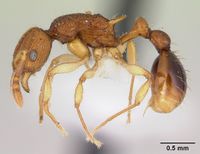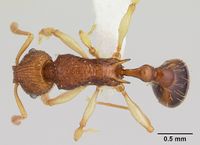Vitsika labes
| Vitsika labes | |
|---|---|

| |
| Scientific classification | |
| Kingdom: | Animalia |
| Phylum: | Arthropoda |
| Class: | Insecta |
| Order: | Hymenoptera |
| Family: | Formicidae |
| Subfamily: | Myrmicinae |
| Tribe: | Crematogastrini |
| Genus: | Vitsika |
| Species: | V. labes |
| Binomial name | |
| Vitsika labes Bolton & Fisher, 2014 | |
The specimens of V. labes were all collected in montane rainforest, in a rotten log, and from litter samples and pitfall traps.
Identification
Bolton and Fisher (2014) - V. labes shares its long, low postpetiolar profile only with Vitsika venustas, but the latter is a smaller species that is yellow in colour; see notes there.
Keys including this Species
Distribution
Endemic to Madagascar.
Latitudinal Distribution Pattern
Latitudinal Range: -15.57166667° to -15.57166667°.
| North Temperate |
North Subtropical |
Tropical | South Subtropical |
South Temperate |
- Source: AntMaps
Distribution based on Regional Taxon Lists
Malagasy Region: Madagascar (type locality).
Distribution based on AntMaps
Distribution based on AntWeb specimens
Check data from AntWeb
Countries Occupied
| Number of countries occupied by this species based on AntWiki Regional Taxon Lists. In general, fewer countries occupied indicates a narrower range, while more countries indicates a more widespread species. |
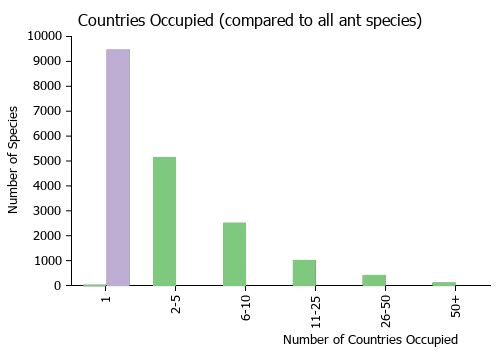
|
Estimated Abundance
| Relative abundance based on number of AntMaps records per species (this species within the purple bar). Fewer records (to the left) indicates a less abundant/encountered species while more records (to the right) indicates more abundant/encountered species. |

|
Biology
Castes
Worker
Images from AntWeb
 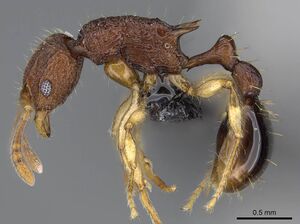  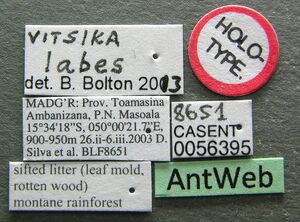
| |
| Holotype of Vitsika labes. Worker. Specimen code casent0056395. Photographer Michele Esposito, uploaded by California Academy of Sciences. | Owned by CAS, San Francisco, CA, USA. |
 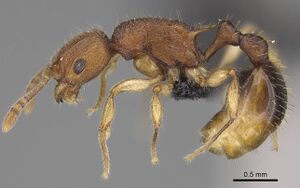 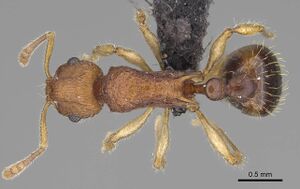 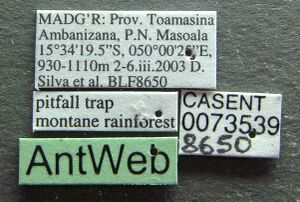
| |
| Worker. Specimen code casent0073539. Photographer Michele Esposito, uploaded by California Academy of Sciences. | Owned by CAS, San Francisco, CA, USA. |
Male
Images from AntWeb
 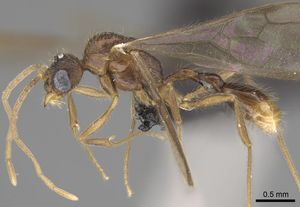 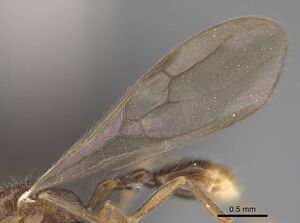  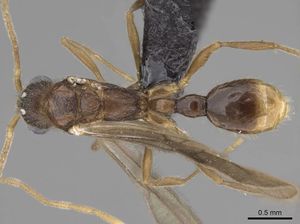 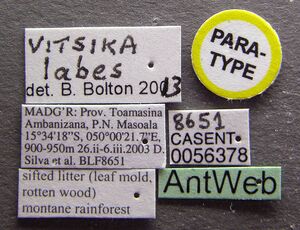
| |
| Paratype of Vitsika labes. Male (alate). Specimen code casent0056378. Photographer Michele Esposito, uploaded by California Academy of Sciences. | Owned by CAS, San Francisco, CA, USA. |
Nomenclature
The following information is derived from Barry Bolton's Online Catalogue of the Ants of the World.
- labes. Vitsika labes Bolton & Fisher, 2014: 82, figs. 99-101, Map 155 (w.q.m.) MADAGASCAR.
Unless otherwise noted the text for the remainder of this section is reported from the publication that includes the original description.
Description
Worker
(holotype in parentheses). TL 3.1–3.7 (3.5), HL 0.68–0.77 (0.74), HW 0.56–0.66 (0.62), CI 82–88 (84), SL 0.48–0.54 (0.52), SI 80–86 (84), PW 0.46–0.56 (0.52), WL 0.88–1.04 (0.98) (12 measured).
Eye with 5–7 rows of ommatidia, and with 6–8 ommatidia in the longest row; EL 0.15–0.19 (EL/HW 0.26–0.29). MfL 0.60–0.72 (MfL/HW 1.03–1.10). In profile, propodeal dorsum with a distinct peak in its outline posterior to the mesonotal-propodeal junction, behind which the dorsum slopes steeply to the upper base of the spine. Propodeal spiracle small, diameter of annulus of spiracle is usually slightly less than the thickness of the propodeal spine at its midlength. Petiole node in profile bluntly rounded dorsally, with the anterior and posterior faces converging. Sculpture of petiole node weak to vestigial laterally, but the side never entirely smooth; posterior surface of petiole node with superficial sculpture, especially basally, but the sculpture fading out dorsally to leave the dorsum smooth. Height of petiole node in posterior view (from midpoint of the dorsal margin of the foramen to the apex) 0.92–1.07 × its maximum width. In dorsal view postpetiole 0.90–1.00 × broader than long; maximum width of postpetiole ca 1.04–1.23 × the length of a propodeal spine; maximum width of postpetiole 0.94–1.00 × the distance between the apices of the propodeal spines. Postpetiole node in profile relatively long and low, its dorsum shallowly convex; the length of the node in profile visibly greater than the height of the segment. Dorsum of postpetiole node superficially reticulate-punctulate, sometimes the sculpture effaced centrally on the disc. Full adult colour reddish brown to dark brown.
Queen
(gyne). Putative ergatoid only known. HL 0.76, HW 0.66, CI 87, SL 0.54, SI 82, PW 0.55, WL 1.08, MfL 0.69 (1 measured). Ocelli absent. Mesosoma worker-like, without trace of wing insertions but with the mesonotum slightly larger than in the worker. Mesopleuron without a transverse sulcus. The identity of the specimen as an ergatoid is based only on the somewhat enlarged mesonotum.
Male
HL 0.58, HW 0.47, CI 81, SL 0.19, SI 40, mesoscutum width at maximum 0.50, WL 1.04, EL 0.28, MfL 0.78 (1 measured). Propodeal dorsum weakly and superficially reticulate-punctulate; dorsum with a weak and slender median carina that also extends down the dorsal half of the declivity. Propodeum unarmed, the dorsum in profile rounds smoothly and evenly into the declivity. Petiole node in profile almost suppressed, long and very low, the node much longer than the petiole is high. Postpetiole in dorsal view much longer than broad, and in profile much longer than high. Colour brown.
Type Material
Holotype worker, Madagascar: Prov. Toamasina, Ambanizana, P.N. Masoala, 15°34’18’’S, 050°00’21.7’’E, 900–950 m., 26.ii.–6.iii.2003, sifted litter (leaf mold, rotten wood), montane rainforest, BLF 8651, CASENT0056395 (D. Silva et al.) (California Academy of Sciences). Paratypes. 5 workers, 1 ergatoid queen and 1 male, with same data as holotype but CASENT numbers 0056372, 006880, 006882, 006886, 006887, 0056373 (ergatoid), 0056378 (male) (CASC).
References
- Bolton, B. & Fisher, B.L. 2014. The Madagascan endemic myrmicine ants related to Eutetramorium (Hymenoptera: Formicidae): taxonomy of the genera Eutetramorium Emery, Malagidris nom. n., Myrmisaraka gen. n., Royidris gen. n., and Vitsika gen. n. Zootaxa 3791:1–99. doi:10.11646/zootaxa.3791.1.1
